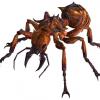I had admittedly put my Pogonomyrmex in a formicarium (Nucleus) that's slightly too big for the colony size. Had 2-3 workers die so now it's just the queen, 3 workers and a small larva. There was one worker who constantly foraged but it died. The group now stays in the bottom chamber. I haven't seen any of them come up to the foraging area nor does any food I offer appear touched.
Should I be worried or will they figure things out? Is it worth disturbing them to move to a smaller house? I actually have a smaller one on the way, which I plan to encourage them to move to on their own.

















